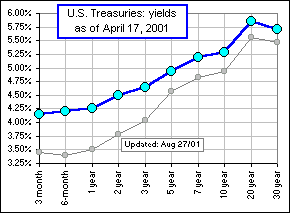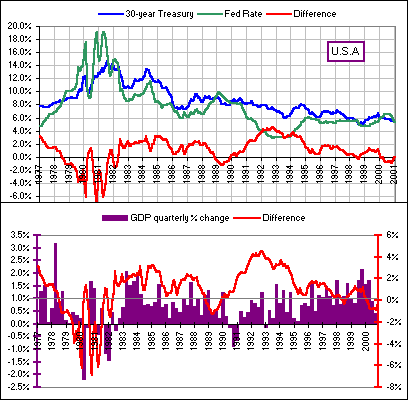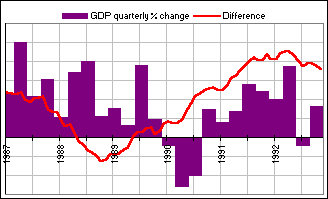| Long versus Short Term Yields |
|
If we plot the yields (or interest rates) for various maturities of
U.S. Treasury bills/bonds on a graph, you see the chart begins on the left with the shortest maturity
(three-month T-bills) and ends on the right with the longest (30-year Treasury Bonds). This is the Yield Curve.
Normally, as the time to maturity increases, the yield increases. Short term rates are set, primarily, by the U.S. Federal reserve (i.e. Greenspan) whereas long term rates are set by market sentiment. Economists (and others!) are interested in the difference between long term (usually 30-year Treasuries) and short term (3-month T bills) rates. |  Fig. 1 |
If the long term rate is (heaven forbid) less than the short term rate, it's an indication of (perhaps) a coming recession - meaning two successive quarters with negative GDP growth.
|
>Perhaps? What does that mean? It has, in the past, been a reasonable indicator of a coming recession. Okay, we'll look at the Fed Rate and 30-year Treasuries and see whether ...
>You said economists look at 3-month T bills, so why the Fed Rate?
>A picture is worth a 1000%. |
 Fig. 1a |
 Fig. 2 |
>Did I tell you the one about the economist who ...? Pay attention: Here's a chart of the Fed Rate and the 30-year Treasuries, from 1977 to 2000 and the Difference between them. There are periods in the early 1980s and early 1990s when this Difference was (heaven forbid) negative! The lower chart shows the quarter-to-quarter percentage change in U.S. Gross Domestic product (as well as the magic Difference). If we regard significant, prolonged decreases in the GDP as a sign of a recession, then it would appear that the negative Difference did indeed predict a recession.
>You're talking about the past and everybuddy knows that past performance
doesn't predict future ... |
|
>Besides, I don't see any predictions in that chart ... Fig. 2, I mean. Let's look more closely at the chart for the early 1990s. Here you can see that the inversion of the yield curve did predict the recession. In fact the inversion lasted as long as the subsequent recession.
>Inversion?
>But... but ... according to Fig. 2 it's inverted right now ... April, 2001! |  Fig. 3 |
Current Yield Curve (compliments of money.cnn): 

